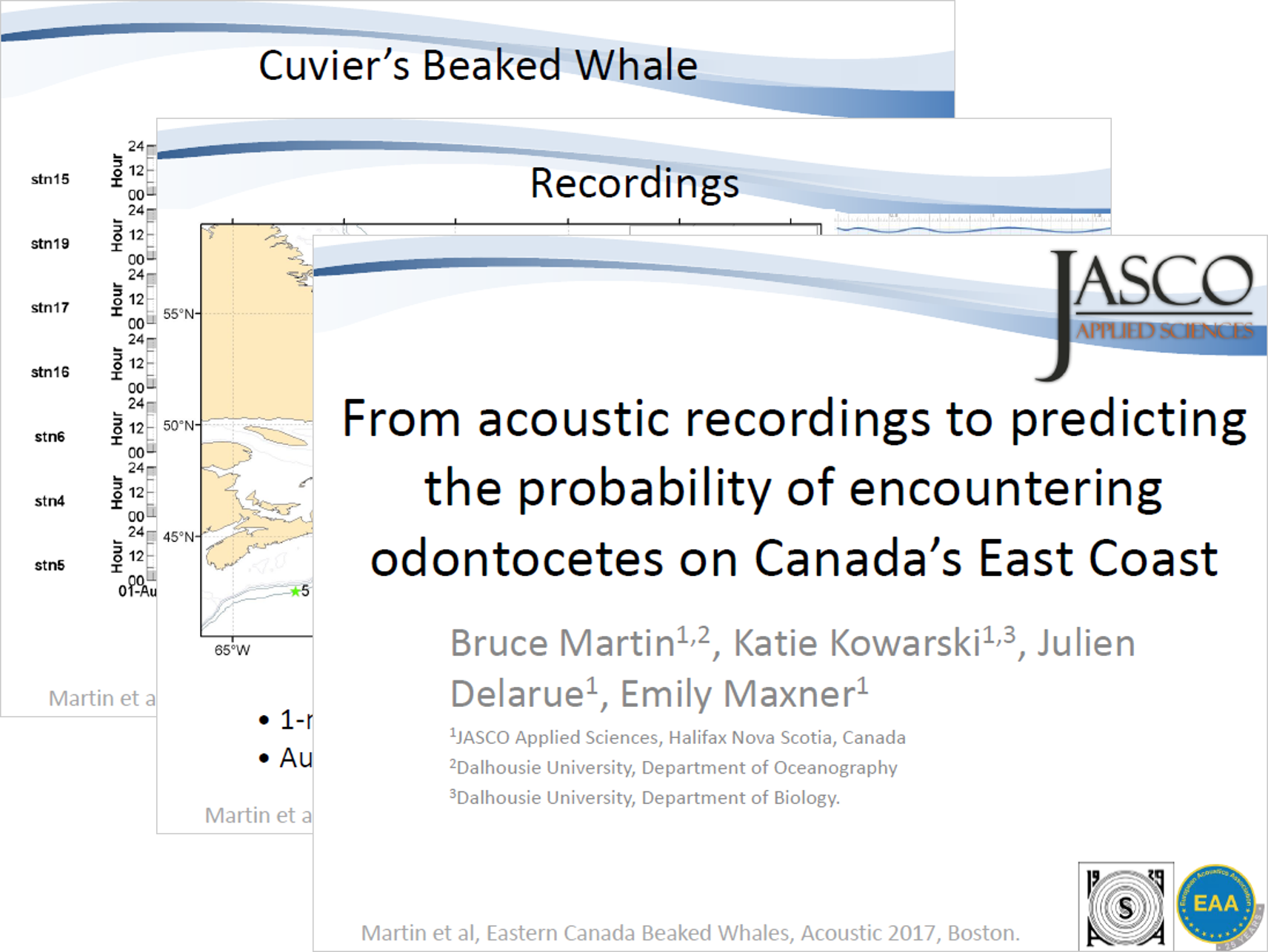Map of the AMAR acoustic recorders deployed off the Canadian East coast for the first of 2 years of underwater acoustic monitoring, Aug 2015 through Jul 2016.
Funded by the Environmental Studies Research Fund (ESRF), JASCO Applied Sciences undertook a 2-year, large-scale underwater acoustic monitoring program across eastern Canadian waters. With 20 Autonomous Multichannel Acoustic Recorders (AMARs) spanning from offshore Halifax to the northern Labrador shelf in waters ranging from 44 to 2000 m, this program was the first of its kind in Atlantic Canada.
The waters off the Canadian Atlantic coast are home to a wealth of marine life including at least 31 species of marine mammals, 10 of which are considered at risk under COSEWIC (Committee on the Status of Endangered Wildlife in Canada). Species considered endangered include:
Northern bottlenose whale (Hyperoodon ampullatus)
Beluga whale (Delphinapterus leucas)
North Atlantic right whale (Eubalaena glacialis)
Blue whale (Balaenoptera musculus)
These species are of particular interest to management bodies because not enough is known about their distribution or habitat to effectively protect and manage them. So one of the overarching goals of this acoustic monitoring program was to learn when and where these whales are present off Atlantic Canada.
The area that was monitored in this study has diverse human activities. These include an extensive amount of fishing, shipping, and oil and gas exploration activities. The contribution of human produced noise to the ocean soundscape has increased in recent decades, a phenomenon largely driven by expanded shipping and oil and gas exploration worldwide. So the second goal of this monitoring program was to better understand the underwater soundscape of the region and monitor areas that are of interest to the oil and gas industry.
A third goal of this program was to perform a transmission loss experiment (to measure the attenuation of sound as it propagates through the water) and acquire geoacoustic profiles of the seabed. In combination with JASCO’s computer models of underwater sound propagation, this data will allow us to better predict the acoustic footprints of seismic surveys in the area.
Public reports of the study results
Julien Delarue, Katie Kowarski, Emily Maxner, Jeff MacDonnell, and Bruce Martin
Environmental Studies Research Fund
Report Number 215 (2018)
Graham Warner, Alexander MacGillivray, and Bruce Martin
Environmental Studies Research Fund
Report Number 216 (2018)
Terry Deveau, Julien Delarue, Bruce Martin, and Klaus Lucke
Environmental Studies Research Fund
Report Number 217 (2018)
Conference presentations from October 2017
These results, from the first year of measurements (2015/2016), were presented at the 22nd Biennial Conference on the Biology of Marine Mammals in Halifax, Nova Scotia in October 2017, hosted by the international Society for Marine Mammalogy.
Bruce Martin, Katie Kowarski, Julien Delarue, and Emily Maxner
Bruce Martin, Jeff MacDonnell, Koen Broker, Aileen Kenney, and Aidan Cole
Emily Maxner, Julien Delarue, Katie Kowarski, Hilary Moors-Murphy, and Bruce Martin
Bruce Martin, Julien Delarue, Katie Kowarski, Emily Maxner , Jeff MacDonnell, Briand Gaudet et al.
Julien Delarue, Katie Kowarski, Emily Maxner, Hillary Moors-Murphy, and Bruce Martin
See the full Conference Program.

![DSC06704[1].jpg](https://images.squarespace-cdn.com/content/v1/52aa2773e4b0f29916f46675/1558704658102-AO7V09KDDJ1KIIKAMBM7/DSC06704%5B1%5D.jpg)
![IMG_0067[1].jpg](https://images.squarespace-cdn.com/content/v1/52aa2773e4b0f29916f46675/1558704664803-VLD44RRV4IJK7HUP90BS/IMG_0067%5B1%5D.jpg)
![IMG_6365[1].jpg](https://images.squarespace-cdn.com/content/v1/52aa2773e4b0f29916f46675/1558704667250-P0BT613CQLLYIDKH8G01/IMG_6365%5B1%5D.jpg)
![DSC06554[1].png](https://images.squarespace-cdn.com/content/v1/52aa2773e4b0f29916f46675/1533323352637-ASCEP1KBKHS95XIVR9DU/DSC06554%5B1%5D.png)












